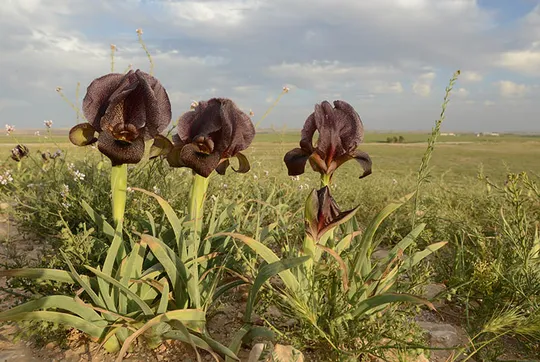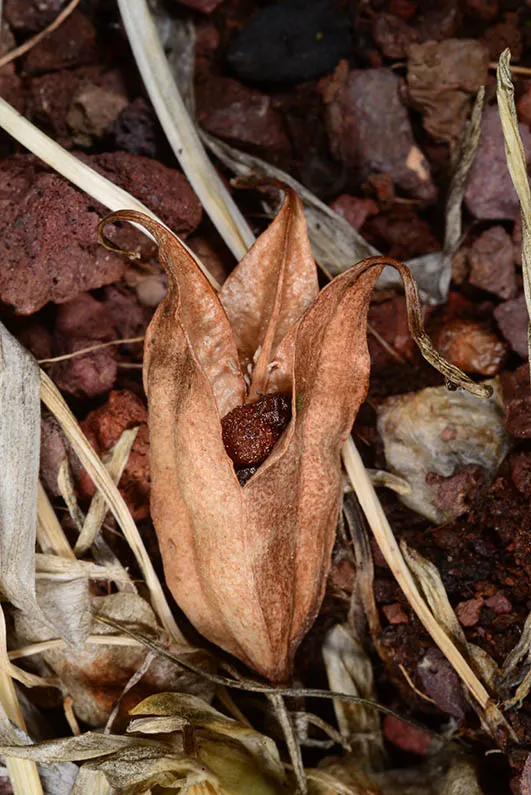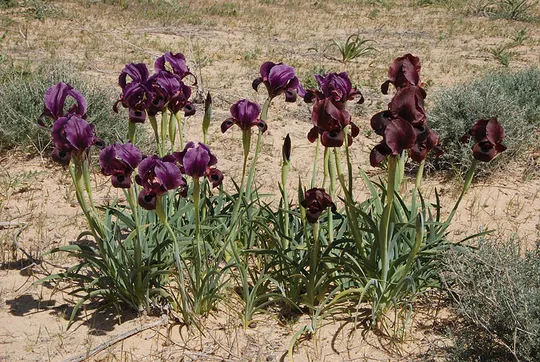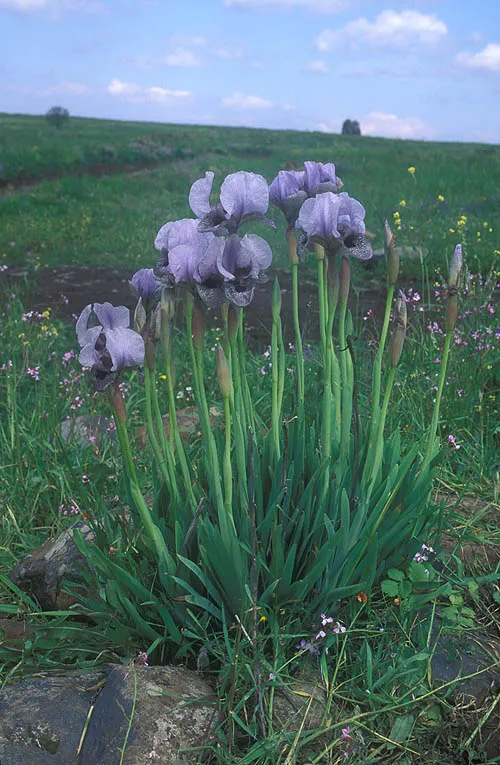Nazareth Iris, Bismarck Iris
Iris bismarckiana
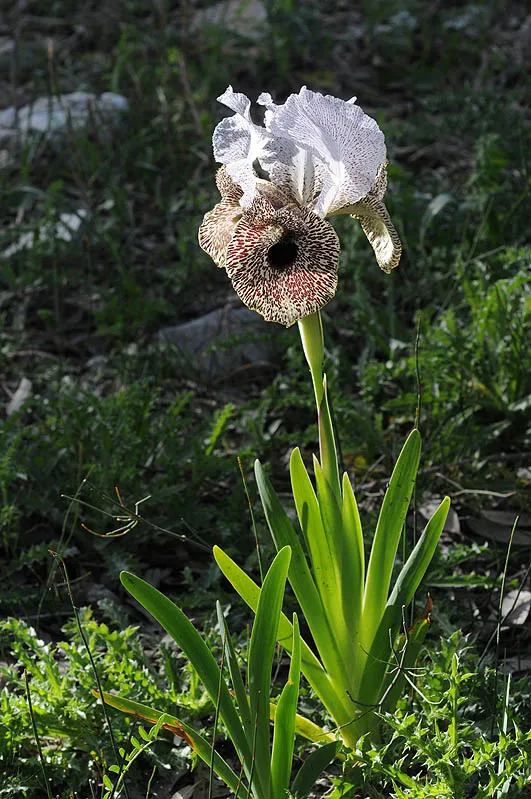
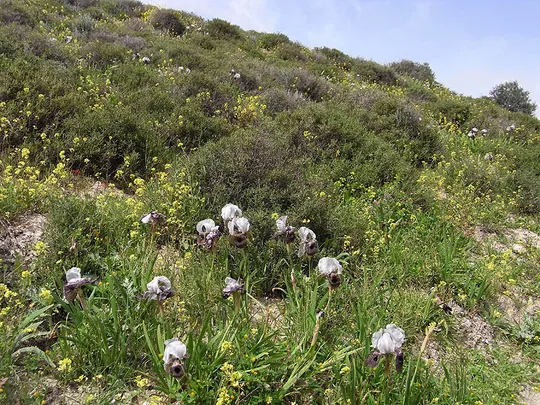
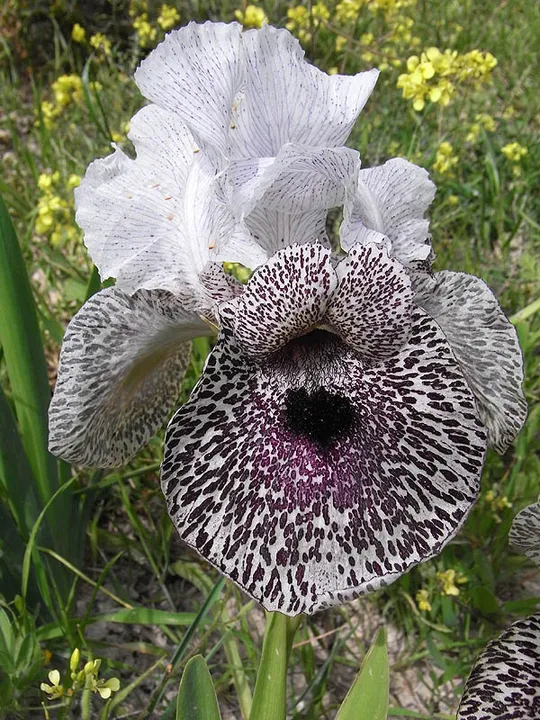
Iris bismarckiana is a geophyte in the Iris section Oncocyclus. Its rhizomes send out thin, long stolons that can reach a few meters. The vegetative growth of the stolons creates large sparse patches, with shoots far apart. The light green knife-shaped leaves emerge from the rhizome like a fan from both sides of the flowering stem. They are wide at the top with rounded ends, and their width is greater than 15 mm. The leaf edges reach the height of the flower and sometimes even extend beyond it. The large flowers are borne on a 30-40 cm stem; flower diameter is 6-8 cm or more. The inner perianth segments ("standards") are light blue, marked with thin, dark azure veins and small spots of the same shade, particularly on their margins. Venation and spotting patterns on the standard vary greatly within the populations and between them. The outer perianth segment is covered in large brown-dark purple spots. These spots merge and create a dark patch at the opening of the flower tube. There is a beard of short black or dark purple hairs at the base of the outer perianth segment (at the opening of the tube).
Due to its beauty, and because they do not require watering, the rhizomes
of Iris bismarckiana and Iris lortetii are often uprooted and
replanted in cemeteries and gardens.
In Israel, Iris bismarckiana grows only in the upper and lower Galilee
and at the western edges of Mt. Hermon. Its range is concentrated mainly on
the Naftali Ridge from the Dishon Stream to Metula. Tens of thousands of individuals
grow around Yiftah, primarily on Mount Mitspe Pe’er. Additional concentrations
are found in the lower Galilee from Giv’at HaMore to Nazareth Illit and the En Mahil
region. Locations in the Hula Valley (Metsad Ateret, HaGome Junction and En Avazim
) and at the Mahoz Ruins (at Tefen, the only location west of the watershed)
are suspected of being planted following relocation. On the Hermon, there are
two sites of Iris bismarckiana, one at the foot of Mount Dov, near the
bottom of Ma’ale Gid’on. This population is similar to the Metula, Ayun Valley
and Naftali Ridge populations. The second site is located at an altitude of
1200-1300 m, at the edge of the village of Maǧdal Shams
on a rocky slope. It is unclear whether this population belongs to Iris hermona
or Iris bismarckiana, and it may possibly be a transition population
between the two species.
Rocky, well-drained slopes at the edges of native woodland or bathas.
Grows on various bedrock and soil types: terra rossa, basalt and light rendzina
soil on rocks from the Senonian and Eocene periods.
The species has been collected in the Nazareth region since the 1860’s. Merchants
from Lebanon and the Galilee brought its rhizomes to Europe. The botanist Regel
first described the species in 1892, based on flowers blooming in European botanical
gardens.
Iris bismarckiana is very similar to I. hermona. Avishai considers
these two taxa as separate species. Regarding the differences between Iris
bismarckiana and Iris hermona, see I. hermona.
·
Urbanization, grazing and afforestation are the primary
threats to the species. The populations in the Nazareth region are constantly declining
due to construction on Mount Yonah since the beginning of the 1980’s and as a
result of intensive grazing and agricultural cultivation. The populations in
the Yiftah area are located in areas undergoing afforestation, security
development, and modification for orchards and quarries. Most of the locations
are far enough from towns or roads, but a few of them are located very close to
the main highway. Access to most of the
locations is easy and convenient. The beautiful flowers of Iris bismarckiana
expose it to picking and uprooting. This is the major reason for the
disappearance of entire populations from Israel and southern Lebanon.
·
Iris bismarckiana has a very patchy distribution pattern, with dense
concentrations in populations with limited distribution. For example, on Giv’at
HaMore, 2,400 shoots were counted, and the population in the central Dishon
Stream is estimated at 60,000 shoots.
·
The species is endemic; the degree of threat in Israel and
Lebanon is therefore equivalent to the degree global endangerment.
·
Iris bismarckiana has been afforded only a moderate degree of nature conservation.
Some of its sites are declared nature reserves – Giv’at HaMore, Enot Sho’im (Nazareth),
Dishon Stream, the replanted concentration east of Yiftah and the Wadi HaShomer/Misgav
streams. The large populations – the Nazareth segment and the Yiftah segment,
are not included in nature reserves, and they are growing smaller. The species is
protected by law and included on the “List of Protected Natural Values.”
There is urgent need of
a rescue and conservation program in the Nazareth area. The proposed nature reserve
on the Naftali Mountains slopes in the Yiftah area should be declared, and
should include and protect Iris bismarckiana sites. The large
populations outside nature reserves, which are known to be threatened, should
be monitored. There is need to survey locations not surveyed in detail up to
now, and to conduct demographic monitoring. Measures should be taken to prevent
uprooting of plants and transferring them to cemeteries and gardens.
Endemic to Israel and southern Lebanon. There evidence of its existence in
southern Lebanon from Ayun Valley north of Metula, and from west of Manara as
well. There is no information regarding the status of the populations in
Lebanon and it is possible that they have become extinct.
This is one of the most
beautiful Israeli flowers; it is endemic to Israel, and possibly grows in
southern Lebanon as well, but is not protected there. In Israel, it is common
in two geographic concentrations: one in the area of Nazareth and Giv’at HaMore,
which was mostly destroyed and is still threatened, and one along the Naftali
Ridge, which is relatively protected and measures should be taken to broaden
its protection. The major threat to Iris bismarckiana comes from the development of natural
areas, but excessive picking and uprooting still constitute a threat.
Current Occupancy Map
| 1000 squre meter pixel | 5000 squre meter pixel | 10000 squre meter pixel | |
|---|---|---|---|
| number of observations | 0 | 0 | 0 |
| in total pixels | 0 | 0 | 0 |
| Family | Iridaceae |
| Classification | On the endangered species list |
| Ecosystem | Mediterranean |
| Chorotype | Eastern Mediterranean |
| Conservation Site | Dishon Stream Nature Reserve, Iris bismarckiana Reserve |
| Rarity |
1
1
6
|
|---|---|
| Vulnerability |
0
1
4
|
| Attractiveness |
0
3
4
|
| Endemism |
0
3
4
|
| Red number |
1
4.2
10
|
| Peripherality | 0 |
| IUCN category | DD EW EX LC CR EN VU NT |
| Threat Definition according to the red book | Endangered |
 Based on:
Based on:
